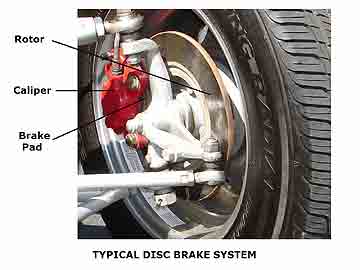When you apply the brakes, you feel a pulsation through the brake pedal and even the steering wheel. You wonder how the brakes and steering are interconnected and what is causing the pulsation. How can it be prevented, and how can it be corrected? And most important, is it a safety issue?

The cause of pulsation and vibration are warped brake rotors. When brakes are applied, the brake calipers press the brake pads against the rotors that rotate with the wheel. If the rotor is warped so the surfaces are not parallel, the caliper pistons are rapidly pushed in and out as the pads contact high and low spots. These pulsations will cause the entire wheel to vibrate. This vibration, often call 'shimmy,' is transmitted to the brake pedal and steering system components to the steering wheel.
While this pulsation can be merely annoying during normal stops, it can be dangerous in a panic stop from high speeds, especially if the warping is severe. Pulsation can affect the proper operation of the anti-lock braking system. Also severe vibration can damage or cause premature wear to the brake system. The damage can be progressive as the warped rotor wears unevenly as it rubs against the brake pads.
There are several causes for warped rotors. It can result from normal wearing of the rotors. It will often occur if you let the brake pads wear to the point where is there is metal-to-metal contact between pads, or what's left of them, and the rotor. Thus, the importance of routine brake pad inspections. Warping can occur if the brakes are very hot after a long trip, or many applications, and then the vehicle is driven through a puddle of cool water.
Incidentally, warped rotors are a bigger problem with the latest models compared to earlier ones fitted with disc brakes. That's because to decrease weight, and thus improve fuel economy, automakers have made brake rotors lighter and more susceptible to warping. Heavier brake rotors can absorb more heat so they are less likely to warp with sudden changes in temperature. While much more expensive vehicles do use carbon fiber and ceramic rotors, most still just use lighter weight, and more warp-prone, steel rotors.
Often pulsations start after a tire has been changed and there is dirt, corrosion or rust on the inner surface of the replaced wheel. This can cause uneven clamping leading to rotor warping. This uneven clamping can also occur from improper tightening of lug nuts. For example, not tightening in the usually recommended two-step, criss-cross tightening technique, and using the improper torque (bolts, lug nets, etc. all use manufacturer-specified levels of torque.) A torque wrench must be used on modern wheels. Air impact wrenches will not torque down the nuts properly. If there is brake pulsating after changing a tire, loosen the nuts and re-torque as soon as possible and you may be able to prevent warping problems.
Can warped rotors be repaired, or must they be replaced? The answer depends on the amount of rotor run-out -- that is the amount the rotor wobbles. In some case, if run-out is more than 0.001 inch, pulsating can occur and other manufacturers allow run-out up to 0.003 inch. Determining run-out requires special equipment.
Often the brake rotors can be repaired, or made "true" on a machine that shaves off a small amount of rotor surface to make the surface smooth and even. However, there are limits on the amounts of material that can be safely removed. If this results in rotor thickness less than specified by the manufacturer, usually stamped into the rotor itself, the rotor must be replaced. This is more likely to happen with the thinner, lighter rotors found on today's vehicles.
Recently, a new technique called Brake Align® has become available. Here specially tapered shims that are located between the rotor and hub to compensate for rotor run-out. According to the company, run-out can be corrected to within .001 inch. Brake Align shims are available for most American and Japanese vehicles.




